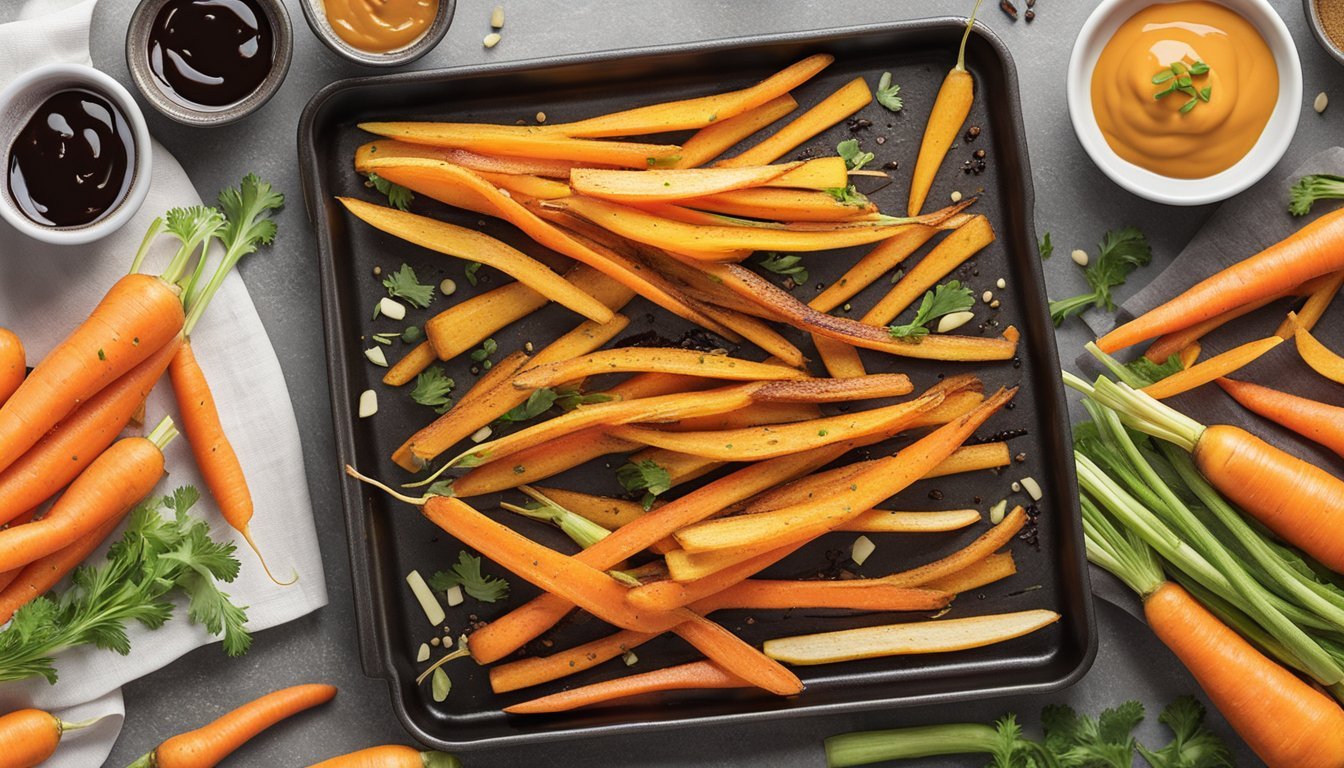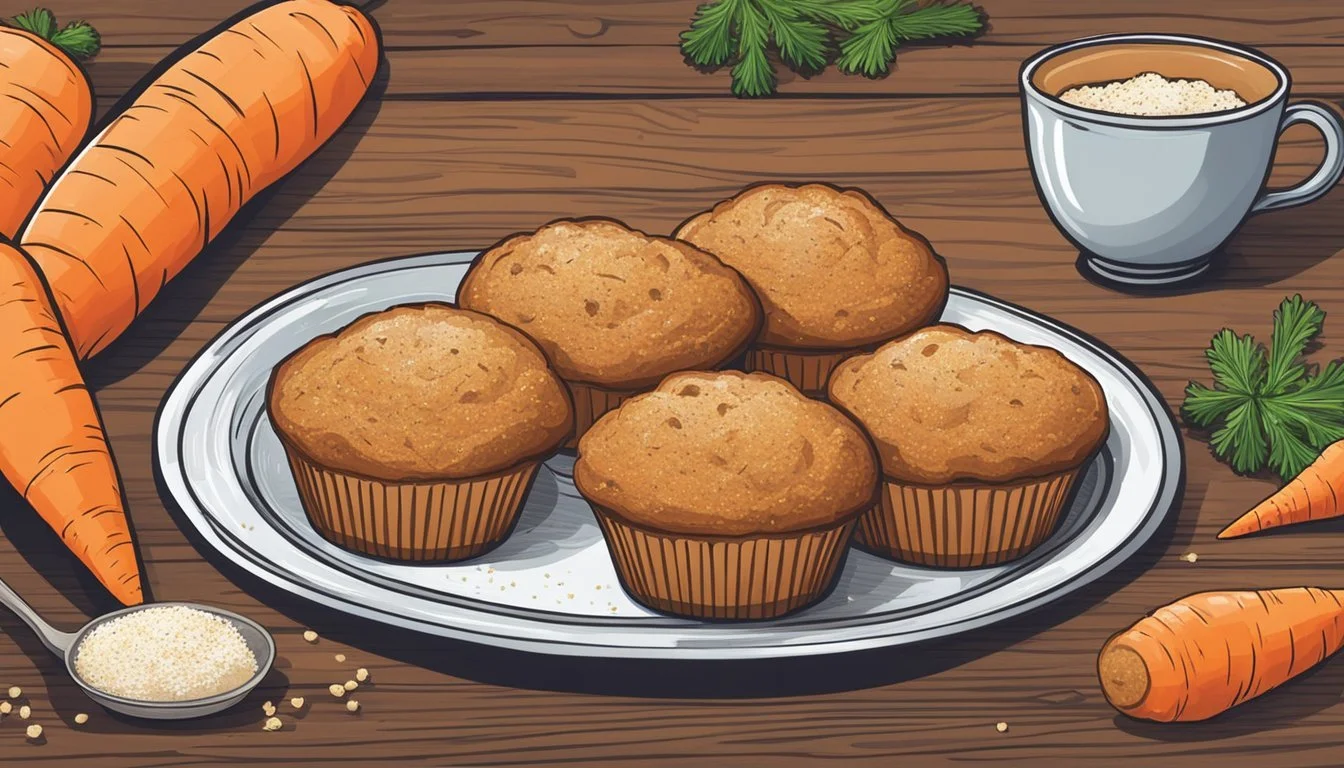10 Delicious Diabetes-Friendly Recipes Using Carrots
Healthy and Tasty Options
Eating well with diabetes can be both enjoyable and nutritious, especially when incorporating versatile vegetables like carrots. These vibrant roots not only add color and flavor to meals but also pack a punch with essential nutrients. Their natural sweetness and low glycemic index make them an ideal choice for those managing blood sugar levels.
This article showcases 10 delicious, diabetes-friendly recipes using carrots, demonstrating that healthy eating doesn't mean compromising on taste. From savory soups to delightful cakes, these recipes are crafted to be both satisfying and mindful of dietary needs.
1) Carrot and Ginger Soup
Carrot and Ginger Soup blends the natural sweetness of carrots with the zesty kick of fresh ginger. This soup is not only a delightful treat for the taste buds but also a nutritious option for those managing diabetes.
Start by sautéing onion, garlic, and ginger in a small amount of vegetable broth until the onions are soft and fragrant. This step enhances the flavors and creates a rich base for the soup.
Next, add chopped carrots and potatoes to the pot. Pour in the remaining vegetable broth and bring the soup to a simmer. Cover and cook until the vegetables are tender, which takes about 20 minutes.
Once cooked, blend the soup to achieve a velvety, smooth texture. You can serve this soup either hot or chilled, making it a versatile dish suitable for any season. Its hearty and wholesome nature ensures it fills you up without any added cream.
Carrot and Ginger Soup is not only easy to prepare but also a great recipe to double and freeze for later, providing a delicious, homemade option at your convenience.
2) Spiced Carrot and Lentil Salad
Spiced Carrot and Lentil Salad offers a delightful combination of flavors and textures, making it a great option for those managing diabetes. This dish is packed with fiber, which helps in regulating blood sugar levels.
To prepare this salad, start by cooking the lentils until they are al dente. Drain them well and mix immediately with cooked carrots to ensure the flavors blend perfectly.
A blend of Middle Eastern spices such as cumin, coriander, and a hint of cinnamon can create a warm and inviting taste. Include freshly chopped cilantro and an extra tablespoon of olive oil to enhance the dish's richness without adding carbohydrates.
Adding freshly ground pepper and adjusting the salt to taste can make the flavors pop. This salad is best served slightly warm, but it can also be enjoyed at room temperature.
This dish not only provides nutritional benefits but also satisfies with its robust and aromatic flavors. Perfect for a quick lunch or a side dish, it can be made in advance and stored for convenience.
3) Balsamic Glazed Carrot Fries
Balsamic Glazed Carrot Fries offer a delightful combination of sweetness and tang, making them a perfect diabetes-friendly side dish. The natural sugars in carrots are balanced by the acidity of balsamic vinegar, creating a flavorful treat without causing significant blood sugar spikes.
To prepare, preheat the oven to 425°F (220°C). Peel and cut carrots into fry-like shapes, ensuring they are uniform for even cooking. In a bowl, toss the carrot fries with olive oil, a drizzle of balsamic vinegar, salt, and pepper. This blend enhances the carrots' natural flavors while keeping the dish light.
Arrange the carrot fries in a single layer on a parchment paper-lined baking sheet. This ensures they cook evenly and get crispy. Bake for about 20-25 minutes. Halfway through the baking time, turn the fries to coat them evenly with the glaze. This step helps in achieving an even, caramelized finish.
Once cooked, these balsamic glazed carrot fries pair well with a variety of main dishes, adding a gourmet touch to everyday meals. The simplicity of the ingredients highlights the carrots' natural taste, making it a delicious addition to a diabetes-friendly diet.
4) Roasted Carrot and Quinoa Bowls
Roasted carrot and quinoa bowls are a delightful and nutritious meal option. This dish combines the earthiness of roasted carrots with the nutty texture of quinoa, making it a diabetes-friendly choice.
To prepare, start by preheating the oven to 400°F (200°C). Peel or scrub the carrots, then cut them into 1/4-inch slices. Toss the carrot slices in olive oil, salt, and pepper.
Place the carrots on a baking sheet lined with foil or parchment paper. Roast in the oven for 20-25 minutes until they are tender and slightly caramelized.
While the carrots are roasting, cook the quinoa according to package instructions. Typically, this involves rinsing the quinoa and simmering it in water until it becomes light and fluffy.
Once the carrots are done, assemble the bowls. Start with a base of quinoa, add the roasted carrots, and incorporate other vegetables like spinach or kale for added nutrition.
For extra flavor, consider adding spices such as paprika, cumin, or turmeric. Garnish with fresh herbs like parsley or cilantro.
These bowls can also be enhanced with a protein source, such as chickpeas or grilled chicken, making them a balanced meal.
5) Carrot and Chickpea Stew
Carrot and Chickpea Stew is a flavorful and nutritious dish that is perfect for those managing diabetes. This stew combines the sweetness of carrots with the heartiness of chickpeas, creating a satisfying meal.
Begin by heating olive oil in a frying pan and cooking onions until translucent. Add carrots and continue to cook for a few more minutes. The key to a delightful stew lies in the spices.
Garlic, cumin, cinnamon, paprika, and cayenne pepper give the stew a fragrant aroma and rich taste. Stir in these spices to coat the vegetables thoroughly and enhance their flavors.
Add vegetable stock, tomatoes, and chickpeas to the mixture. Bring the stew to a simmer and let it cook on low heat until the carrots are tender. This usually takes about 30-40 minutes.
For added creaminess and balance, a dollop of crème fraîche can be stirred in before serving. Make sure to taste and adjust the salt as needed.
Serve the stew warm, garnished with fresh parsley. This dish pairs well with a slice of whole-grain bread or a side salad for a complete, diabetes-friendly meal.
6) Carrot Ginger Muffins
Carrot Ginger Muffins offer a delightful blend of flavors and are perfect for those seeking a diabetes-friendly option. These muffins combine the sweetness of carrots with the zest of ginger, creating a unique and tasty treat.
Preheat the oven to 350°F. Line a 12-cup muffin pan with paper liners and lightly spray the insides with oil. This prevents sticking and ensures an easy release after baking.
The recipe starts by toasting pecans in the oven for about 5 to 10 minutes until fragrant. Set them aside to cool before incorporating them into the batter. Toasted pecans add a crunch and nuttiness to the muffins.
In a large bowl, whisk together the dry ingredients: flour, sugar substitute, baking powder, baking soda, cinnamon, ginger, and salt. Ensure these are well-blended to distribute the spices evenly throughout the batter.
In a separate bowl, whisk together the wet ingredients: oil, unsweetened applesauce, eggs, and vanilla extract. Combining the wet and dry ingredients carefully prevents over-mixing, which can lead to dense muffins.
Fold in the grated carrots and toasted pecans into the batter. The carrots not only provide natural sweetness but also a moist texture. Spoon the batter into the prepared muffin tin, filling each cup about two-thirds full.
Bake for 18-22 minutes until a toothpick inserted into the center of a muffin comes out clean. Let the muffins cool in the pan for a few minutes before transferring them to a wire rack. Enjoy these Carrot Ginger Muffins as a healthy snack or breakfast option.
7) Thai Carrot and Peanut Noodles
Thai Carrot and Peanut Noodles offer a flavorful and diabetes-friendly meal choice. This dish combines the natural sweetness of carrots with the rich, savory taste of peanut sauce. It's a healthy option that manages to be both nutritious and satisfying.
Begin by making the peanut sauce. Mix rice vinegar, soy sauce, lime juice, honey, garlic, peanut butter, and red pepper flakes until smooth. Adjust salt to taste.
Heat a large frying pan or wok over medium-high heat. Add coconut oil and sauté onions until they start to soften. Add carrots and red peppers, then pour in water. Cover and let steam for a couple of minutes until the carrot noodles soften.
Next, fold in the prepared peanut sauce, making sure the noodles are well-coated. Continue to cook for a short time to meld the flavors.
To serve, garnish with fresh cilantro and chopped peanuts for added crunch. This dish not only meets dietary needs but also delivers a delightful eating experience.
8) Carrot and Zucchini Fritters
Carrot and zucchini fritters offer a tasty and nutritious option for those managing diabetes. Start by shredding the carrots and zucchini using a food processor or cheese grater. Squeeze out any excess liquid with a cheesecloth to ensure the fritters hold together well.
Next, combine the shredded vegetables in a large bowl with finely chopped fresh dill, minced garlic, eggs, and flour. Season with salt and black pepper to enhance the flavor. Mixing thoroughly ensures the ingredients are well-incorporated.
Heat a large skillet over medium-high heat and add a small amount of olive oil. Using a 1/4 cup measuring cup, scoop the vegetable mixture and carefully place it into the hot skillet. Flatten the batter slightly to form fritters.
Cook the fritters for a few minutes on each side until they are golden brown and crispy. Serve warm, possibly with a side of Greek yogurt or a fresh herb sauce to complement the fritters. These fritters make an excellent, diabetes-friendly snack or side dish, rich in fiber and flavor without unnecessary carbs.
9) Carrot Hummus
Carrot hummus offers a nutritious twist on the classic chickpea dip. This version combines roasted carrots with traditional hummus ingredients to create a creamy and flavorful spread that's perfect for anyone, including those with diabetes.
To start, preheat the oven to 425°F. Place chopped carrots on a baking sheet lined with parchment paper. Toss the carrots with olive oil, cumin, and salt. Roast them until tender and caramelized, about 30 minutes.
Once the carrots are roasted, let them cool slightly. Then, blend the cooled carrots with chickpeas, tahini, lemon juice, and more olive oil. Adding spices like smoked paprika or ginger can enhance the flavor further.
To achieve a smooth texture, consider using a high-powered blender or food processor. If the hummus is too thick, a splash of water or chickpea liquid (aquafaba) can help reach desired consistency.
Carrot hummus can be served with fresh veggies, whole-grain crackers, or used as a spread for sandwiches. It not only adds a vibrant color to your plate but also provides fiber, vitamins, and minerals essential for a well-balanced diet.
10) Carrot and Orange Smoothie
Carrot and orange smoothies combine the natural sweetness of carrots with the tang of oranges. This vibrant drink is a refreshing option for those looking to maintain healthy blood sugar levels.
To make it, start by peeling and roughly chopping fresh carrots. In a blender, add the chopped carrots, fresh orange juice, and some finely shredded orange peel.
Blend until smooth. For a chilled, thicker consistency, add ice cubes and blend again. The result is a nutrient-packed smoothie that's rich in vitamins A and C, essential for overall diabetes management.
For added flavor, consider mixing in a small amount of ginger or cinnamon. This can enhance the taste while providing potential benefits for blood sugar control.
Enjoy this carrot and orange smoothie as part of a balanced diet to help manage diabetes effectively.
Nutritional Benefits of Carrots for Diabetes
Carrots offer several nutritional advantages for individuals with diabetes. Their low glycemic index (GI) and high fiber content make them a beneficial addition to a diabetes-friendly diet.
Low Glycemic Index of Carrots
Carrots are considered a low-GI food, with a GI rating of 41. This metric indicates that consuming carrots causes a slow and steady rise in blood sugar levels.
Eating foods with a low GI helps prevent sharp spikes and crashes in blood sugar, which is crucial for diabetes management.
Studies have shown that the glycemic response of carrots doesn’t fluctuate significantly, whether they are eaten raw or cooked. This stability makes them a versatile ingredient in diabetic-friendly recipes.
Key Point: The consistent glycemic response of carrots helps maintain stable blood sugar levels.
High Fiber Content
Carrots are rich in dietary fiber, offering approximately 2 grams per medium-sized carrot. This fiber aids in digestion and contributes to a feeling of fullness, which can help control overeating.
For individuals with diabetes, the fiber in carrots assists in modulating blood sugar levels by slowing the absorption of sugars into the bloodstream.
Additionally, the soluble fiber in carrots can lower cholesterol, which is beneficial for heart health—an important consideration for people with diabetes.
Key Point: The high fiber content in carrots supports blood sugar regulation and promotes digestive health.
Nutritional Breakdown of a Medium-Sized Carrot:
Calories: 25
Fat: 0g
Sodium: 40mg
Carbohydrates: 6g
Fiber: 2g
Key Ingredients to Avoid in Diabetes-Friendly Recipes
Managing diabetes involves careful selection of ingredients to keep blood sugar levels stable. Certain food items should be avoided to ensure meals are healthy and safe.
Refined Sugars
Refined sugars, such as those found in white sugar and high-fructose corn syrup, rapidly increase blood glucose levels. They add empty calories and have no nutritional benefits. Common sources include:
Sodas
Candy
Baked goods
Sugary cereals
Substitute with natural sweeteners like stevia or small amounts of honey to better manage blood sugar levels.
High-Carbohydrate Foods
High-carbohydrate foods cause spikes in blood sugar that can be difficult to control. Foods like white bread, white rice, and pasta convert quickly into glucose.
Alternatives include:
Whole grains
Vegetables
Legumes
Monitoring and reducing carbohydrate intake helps maintain better blood sugar control and overall health. Select complex carbs with a lower glycemic index to minimize impact on blood sugar.










